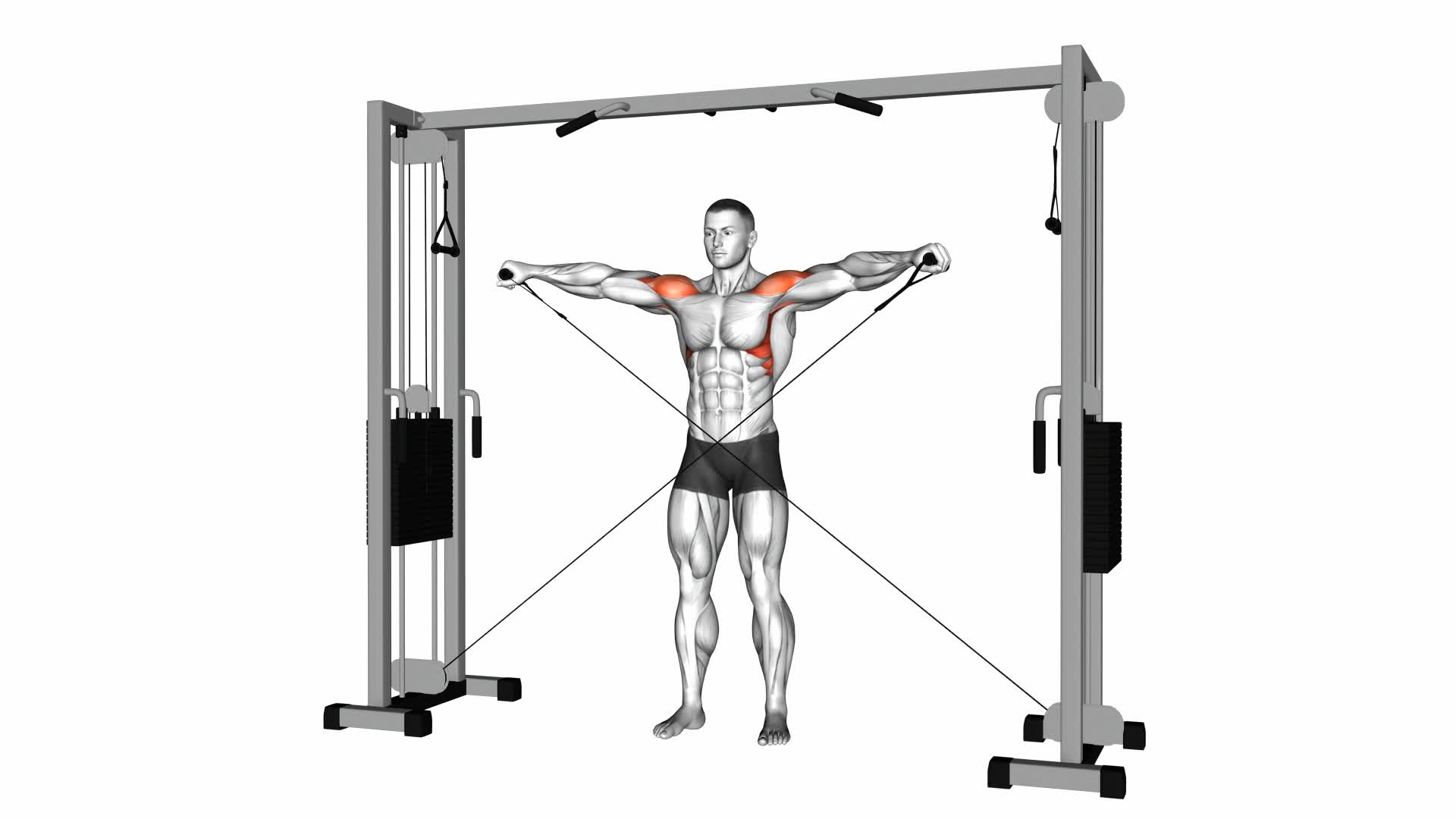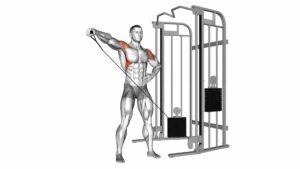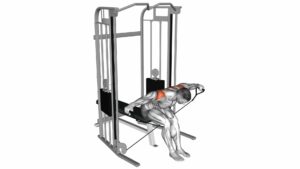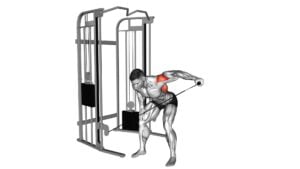Cable Lateral Raise – Video Exercise Guide & Tips

Looking to strengthen and sculpt your shoulders? Look no further than the cable lateral raise. This exercise targets your deltoids, helping you achieve those defined, rounded shoulders.
Watch This Exercise Video
In this video exercise guide, we'll show you the proper form and technique, variations for progressive overload, and common mistakes to avoid.
Plus, we'll share tips to maximize your results. Get ready to take your shoulder workout to the next level with the cable lateral raise.
Key Takeaways
- Cable lateral raises increase shoulder strength and stability.
- They target the lateral deltoid muscles.
- Performing cable lateral raises can improve performance in other upper body exercises.
- Proper form and technique, such as maintaining proper posture and using controlled movements, are crucial for maximizing results.
Benefits of Cable Lateral Raises
You'll experience increased shoulder strength and stability when performing cable lateral raises. Cable lateral raises are a highly effective exercise that targets the lateral deltoid muscles, which are responsible for shoulder abduction.
Incorporating cable lateral raises into your workout routine offers several benefits.
One of the main benefits of cable lateral raises is improved shoulder strength. The resistance provided by the cable machine helps to build strength in the lateral deltoids, making them more capable of handling heavier loads. This increased strength translates to improved performance in other upper body exercises such as overhead presses and bench presses.
In addition to strength, cable lateral raises also improve shoulder stability. The controlled movement of raising the cables laterally forces the deltoids to stabilize the shoulder joint. This stability is crucial for preventing injuries during other exercises and daily activities.
Another reason to incorporate cable lateral raises into your workout routine is the ability to target and isolate the lateral deltoids. Unlike traditional lateral raises with dumbbells, the constant tension provided by the cable machine ensures that the lateral deltoids are fully engaged throughout the entire range of motion.
To ensure you get the most out of your cable lateral raises, it's important to maintain proper form and technique.
Proper Form and Technique
To perform cable lateral raises with proper form and technique, start by standing upright and gripping the cable handles. Stand with your feet shoulder-width apart, knees slightly bent, and core engaged. Keep your shoulders relaxed and down, and maintain a slight bend in your elbows throughout the exercise.
To initiate the movement, exhale and raise your arms out to the sides until they're parallel to the floor. Be sure to avoid any swinging or jerking motions as you lift the weight. Focus on using your shoulder muscles to control the movement and keep your body stable.
Maintain shoulder stability by keeping your wrists in a neutral position and avoiding excessive shrugging or leaning forward. This will ensure that the targeted muscles are properly activated and that your shoulders are protected from injury.
Muscle activation is key in this exercise, so concentrate on squeezing your shoulder blades together at the top of the movement and maintaining tension in the lateral deltoids throughout.
Now that you understand the proper form and technique for cable lateral raises, let's move on to the next section about variations for progressive overload.
Variations for Progressive Overload
To continue building upon your cable lateral raise technique, let's explore variations for progressive overload. By incorporating these progressive overload techniques, you can continue to challenge your muscles and make further progress in your strength and muscle-building goals.
Here are four variations you can try:
- Increase the weight: One of the simplest ways to progress is by increasing the weight you use during the exercise. Gradually increase the resistance to ensure that your muscles are continually challenged.
- Change the grip: Experiment with different hand positions to target your muscles from different angles. You can try a pronated grip (palms facing down), a neutral grip (palms facing each other), or a supinated grip (palms facing up) to engage different muscle fibers.
- Vary the equipment: In addition to using the cable machine, you can also perform lateral raises using dumbbells, resistance bands, or even kettlebells. Each equipment option provides a slightly different stimulus to your muscles.
- Incorporate drop sets: After completing a set with a challenging weight, immediately reduce the weight and continue performing the exercise. This technique helps to exhaust your muscles and promote further muscle growth.
By incorporating these variations and progressive overload techniques, you can continue to challenge your muscles and avoid plateaus in your cable lateral raise routine.
Now, let's move on to discussing common mistakes to avoid.
Common Mistakes to Avoid
To avoid common mistakes while performing cable lateral raises, focus on maintaining proper form and technique. One common mistake to avoid is using too much weight. It's important to start with a weight that you can comfortably handle and gradually increase as you get stronger. Using too much weight can lead to improper form and put unnecessary strain on your muscles and joints.
Another mistake to avoid is swinging your body or using momentum to lift the weight. This takes away the focus from your lateral deltoids and can result in an ineffective workout. Instead, keep your body still and use controlled movements to lift the weight.
Improper execution of the exercise is another common mistake. Make sure to keep your arms straight with a slight bend in your elbows throughout the movement. Avoid fully extending your arms or bending them too much, as this can lead to strain or injury.
Lastly, avoid raising your arms too high or too low. The optimal range of motion for cable lateral raises is to lift your arms until they're parallel to the floor. Going higher than this can strain your shoulders, while going lower can minimize the effectiveness of the exercise.
Tips for Maximizing Results
To maximize your results from cable lateral raises, focus on proper form and technique while incorporating these tips:
- Warm up before starting your workout: Performing warm up exercises is crucial to prepare your muscles and joints for the movements involved in cable lateral raises. It increases blood flow to the targeted muscles and helps prevent shoulder injuries.
- Maintain proper posture and alignment: Stand tall with your feet shoulder-width apart, and engage your core muscles. Keep your spine neutral and avoid leaning forward or backward during the exercise. This ensures that the tension is placed on the lateral deltoids, maximizing their activation.
- Use controlled movements: Avoid using momentum to perform the exercise. Instead, focus on slow and controlled movements, lifting the weights out to the sides and maintaining a slight bend in your elbows. This allows for greater muscle engagement and reduces the risk of injury.
- Gradually increase weight and reps: As you become more comfortable with the exercise, gradually increase the weight and reps to continue challenging your muscles. This progressive overload stimulates muscle growth and strength gains over time.
Frequently Asked Questions
How Often Should I Incorporate Cable Lateral Raises Into My Workout Routine?
To optimize your workout routine, it's important to consider the frequency of cable lateral raises.
Incorporating cable lateral raises into your routine can provide numerous benefits. These exercises target your lateral deltoids, helping to build shoulder strength and definition.
However, the ideal frequency will depend on your specific goals and fitness level. It's recommended to start with 2-3 sessions per week and gradually increase as you progress.
Remember to listen to your body and consult a fitness professional for personalized advice.
Can Cable Lateral Raises Help Improve My Posture?
Cable lateral raises can be beneficial for improving your posture. By targeting the lateral deltoids, this exercise helps to strengthen the muscles responsible for keeping your shoulders in proper alignment.
As a result, your upper body posture can improve, reducing the likelihood of slouching or rounded shoulders. Incorporating cable lateral raises into your workout routine can be an effective way to promote better posture and maintain a strong, upright position.
Is It Necessary to Use a Specific Grip When Performing Cable Lateral Raises?
When performing cable lateral raises, it's important to consider the grip you use. Using a specific grip can help target different muscles and provide variation in the exercise.
By altering your grip, you can focus on different parts of your shoulder and arm muscles. Experiment with different grips, such as overhand or underhand, to see which one feels most comfortable and effective for you.
Keep in mind that there are alternative variations of the cable lateral raise that can also target specific muscles.
Are There Any Modifications for Individuals With Shoulder Injuries or Limitations?
If you have a shoulder injury or limited mobility, there are modifications you can make to the cable lateral raise exercise. These modifications can help you to still work your shoulder muscles without putting too much strain on the injured area.
By adjusting the weight, range of motion, or using alternative exercises, you can tailor the workout to your specific needs.
It's important to consult with a professional or physical therapist to determine the best modifications for your situation.
Can Cable Lateral Raises Be Effective for Targeting Specific Muscle Groups, Such as the Rear Deltoids or Traps?
Cable lateral raises can be highly effective for targeting specific muscle groups, such as the rear deltoids or traps. These exercises provide numerous benefits for shoulder stability, helping to strengthen and tone the muscles surrounding the shoulder joint.
To perform cable lateral raises properly for maximum results, stand upright with a slight bend in your knees, hold the cable handles at your sides, and lift your arms out to the sides until they're parallel to the ground.
Conclusion
To conclude, cable lateral raises are an effective exercise for targeting and strengthening the shoulder muscles. By maintaining proper form and technique, you can maximize the benefits of this exercise while avoiding common mistakes.
Additionally, incorporating variations and progressive overload techniques can help you continually challenge your muscles and promote growth. Remember to listen to your body and consult with a professional if you have any concerns.
Keep up the good work and enjoy the results of your hard work!

Author
Years ago, the spark of my life’s passion ignited in my mind the moment I stepped into the local gym for the first time. The inaugural bead of perspiration, the initial endeavor, the very first surge of endorphins, and a sense of pride that washed over me post-workout marked the beginning of my deep-seated interest in strength sports, fitness, and sports nutrition. This very curiosity blossomed rapidly into a profound fascination, propelling me to earn a Master’s degree in Physical Education from the Academy of Physical Education in Krakow, followed by a Sports Manager diploma from the Jagiellonian University. My journey of growth led me to gain more specialized qualifications, such as being a certified personal trainer with a focus on sports dietetics, a lifeguard, and an instructor for wellness and corrective gymnastics. Theoretical knowledge paired seamlessly with practical experience, reinforcing my belief that the transformation of individuals under my guidance was also a reflection of my personal growth. This belief holds true even today. Each day, I strive to push the boundaries and explore new realms. These realms gently elevate me to greater heights. The unique combination of passion for my field and the continuous quest for growth fuels my drive to break new ground.







